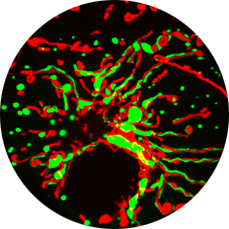 Human development, on which the future child's health depends, is a complex phenomenon within the female starting with egg-spermatozoa fusion. In each individual, a plethora of molecular recognition events mediate the development of an immune system to defend against pathogens, a musculoskeletal system to maintain the body, and flexible networks of molecular expression to manage environmental stress. Traditionally, studies of these processes are divided into biochemistry, cell biology, virology, toxicology, etc. However, nature does not know these artificial divisions, and new understandings emerge from the crucible that interfaces mathematically minded physical scientists with biomedical researchers. The Physical Biology and Medicine Group is a unique scientific body that approaches human development in normal life and pathology as an integral process and encompasses first-class cell biologists, physical chemists, biophysicists, virologists, and immunologists who not only successfully train postdocs and students within their own fields, but widely collaborate, building and uniquely promulgating multidisciplinary approaches to the most important biomedical problems in the framework of the NICHD mission.
Human development, on which the future child's health depends, is a complex phenomenon within the female starting with egg-spermatozoa fusion. In each individual, a plethora of molecular recognition events mediate the development of an immune system to defend against pathogens, a musculoskeletal system to maintain the body, and flexible networks of molecular expression to manage environmental stress. Traditionally, studies of these processes are divided into biochemistry, cell biology, virology, toxicology, etc. However, nature does not know these artificial divisions, and new understandings emerge from the crucible that interfaces mathematically minded physical scientists with biomedical researchers. The Physical Biology and Medicine Group is a unique scientific body that approaches human development in normal life and pathology as an integral process and encompasses first-class cell biologists, physical chemists, biophysicists, virologists, and immunologists who not only successfully train postdocs and students within their own fields, but widely collaborate, building and uniquely promulgating multidisciplinary approaches to the most important biomedical problems in the framework of the NICHD mission.
By choosing carefully which biophysical projects really answer the fundamental problems that limit advancement in medicine, we as a group will suffuse these identified problems with our basic wisdom of biophysics. This wisdom includes a deep knowledge of polymer physics, membrane biology and virology, inter- and intracellular communication, the theory of transporters and diffusion of domains, the physics of channel permeation and protein conformational change, the physical chemistry of membrane hydration forces and recognition, the physiology of cell signaling and receptor activation, lipid/protein interactions, and the physiology of secretion, viral infection, parasite invasion, fertilization, adipose transporter trafficking and insulin signaling, and developmental cell fusion. Our strategy is to sharpen our techniques and power of observation to prove our discoveries, including proteomic architecture of signaling complexes and cellular structures, TIRF microscopy, long-term live-cell time-lapse imaging of tissue and cultured cells, confocal and two-photon scanning microscopy, electrophysiology, physical theories to devise experimental tests of hypotheses, cryoelectron microscopy, and lipidomic analyses.
We are now in a position to tackle the developmental changes seen in obesity and genetic disorders, the pathophysiology of influenza, dengue, and HIV viral infection and assembly, a 3D immunohistochemical microscopy of normal and compromised placenta at super-resolution levels, the use of human brain culture in dissociated and slice culture to study traumatic brain injury and glioblastomal neoplasia, membrane domain organization, regulation of mitochondrial metabolism by cytosolic proteins, and muscle molecular ultrastructure. We currently anticipate testing if hydrogen bond theory can explain hydration repulsion of DNA and membranes, developing a deeper understanding of mechanical, electrical, and chemical interactions in complex, multicomponent cell communities, achieving the conceptual integration of cutting-edge immunological information and assays for cell-cell communication in the onset of tissue pathology and discovering the role and mechanisms of microRNA vehicles in serum.
Labs within this group include (alphabetically):

 BACK TO TOP
BACK TO TOP